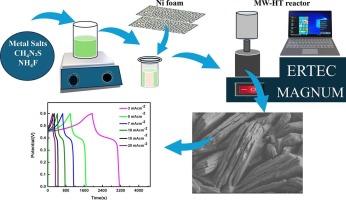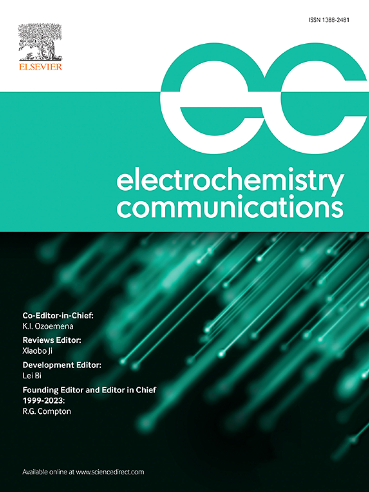基于zno掺杂Ni3S2垂直生长二维纳米结构的无粘结剂电极在Ni泡沫上具有提高电化学性能的储能应用
IF 4.2
3区 工程技术
Q2 ELECTROCHEMISTRY
引用次数: 0
摘要
过渡金属硫化物在电化学储能领域引起了广泛的关注。然而,由于电极在制造过程中存在堆积缺陷,影响了其性能。在这项研究中,我们报道了通过一步、快速、节能和经济的微波辅助方法在导电泡沫镍上垂直生长zn掺杂Ni3S2的二维纳米结构。透射电子显微镜(TEM)和高分辨率透射电子显微镜(HR-TEM)分析证实了最初通过扫描电子显微镜(SEM)和x射线衍射(XRD)鉴定的形态和相组成。电化学研究证实了电极的性能提高,在放电电流为3 mA cm−2时,比电容值为1984 F g−1和5.95 F cm−2。随后,该电极在世伟洛克电池中作为正极和石墨烯纳米颗粒作为负极进行测试,在放电电流为1 ag−1的情况下,获得了45.5 Whkg−1和910 Wkg−1的最大能量密度。这种无粘结剂纳米结构电极的赝电容特性,由可逆氧化还原反应驱动,突出了它们在高性能储能应用中的潜力。本文章由计算机程序翻译,如有差异,请以英文原文为准。

Binder-free electrode based on Zn-doped Ni3S2 vertically grown 2-dimensional nanostructures on Ni foam with boosted electrochemical performance for energy storage applications
Transition metal sulfides have drawn a lot of interest in the field of electrochemical energy storage. However, their performance is hampered due to the stacking faults during the electrode fabrication. In this study, we report the Zn-doped Ni3S2 vertically grown 2-dimensional nanostructures on the conductive nickel foam by a one-step, rapid, energy-efficient, and cost-effective microwave-assisted method. Transmission electron microscopy (TEM) and high-resolution transmission electron microscopy (HR-TEM) analyses confirmed the morphological and phase composition as initially identified by scanning electron microscopy (SEM) and X-ray diffraction (XRD). The electrochemical investigations substantiated the boosted performance of the electrode, an impressive specific capacitance value of 1984 F g−1 and 5.95 F cm−2 at a discharge current of 3 mA cm−2. Later on, this electrode, when tested in a Swagelok cell as a positive electrode and graphene nano pellets as a negative electrode, achieved a maximum energy density of 45.5 Whkg−1 and 910 Wkg−1 power at a discharge current rate of 1 A g−1. The pseudocapacitive characteristics of this binder-free nanostructured electrode, driven by reversible redox reactions, highlight their potential for high-performance energy storage applications.
求助全文
通过发布文献求助,成功后即可免费获取论文全文。
去求助
来源期刊

Electrochemistry Communications
工程技术-电化学
CiteScore
8.50
自引率
3.70%
发文量
160
审稿时长
1.2 months
期刊介绍:
Electrochemistry Communications is an open access journal providing fast dissemination of short communications, full communications and mini reviews covering the whole field of electrochemistry which merit urgent publication. Short communications are limited to a maximum of 20,000 characters (including spaces) while full communications and mini reviews are limited to 25,000 characters (including spaces). Supplementary information is permitted for full communications and mini reviews but not for short communications. We aim to be the fastest journal in electrochemistry for these types of papers.
 求助内容:
求助内容: 应助结果提醒方式:
应助结果提醒方式:


